Airport car parks are renowned for their expansive floor plans and multiple levels, which can make locating one’s vehicle difficult – a problem that advances in camera-based technology could now put an end to. Future Airport speaks to Michel van Scherpenzeel, European sales manager at Park Assist, about how the company is revolutionising the visitor parking experience.
How did the concept of the M4 system come about and what preexisting issues did it aim to overcome?
Michel van Scherpenzeel: Park Assist began as a company that provided traditional ultrasonic systems; but these kinds of systems could only detect cars – that was it. Then customers asked us if we could do something to provide an answer to ‘lost-my-car syndrome’, so we came up with the world’s first camera-based solution with integrated licence plate recognition (LPR) back in 2010. Early last year, we launched a new upgrade – our fourth-generation sensor, called M4. We now have installations in 20 countries worldwide.
The camera-based solution with LPR helped to put an end to the lost-my-car syndrome along with the software extension Park Finder. With this module you can easily locate your car on strategically placed kiosks or by using your smartphone. Later on, we developed more software extensions to help increase our parking revenues and boost customer satisfaction.
What are the benefits of the Park Assist M4 system for an airport?
Apart from Park Finder, airports mostly use our extensions Park SelectRate and Park Vision.
With Park SelectRate, you can easily designate spaces for premium pricing or other pricing strategies without the use of extra (expensive) barriers. Park SelectRate can easily be integrated into existing parking management systems. Operators can add, change, assign and delete rates – and adjust the smart-sensor LED colours – as needed. It’s very simple to implement and a real money-maker.
With the addition of Park Vision, our camera smart-sensor system is able to capture streaming video whenever motion is detected in or around a space. As the sensors are installed above each driving lane, the cameras have an unobstructed view of every car in the parking facility. This provides an expanded level of security that would otherwise be cost-prohibitive. It also gives the customers peace of mind, knowing their vehicles are effectively monitored.
Which airports has Park Assist been installed in?
We now have installations at several large airports in Australia and New Zealand, and at Fort Lauderdale-Hollywood International Airport in Florida, US. In Europe we have many interested airports, and we expect to have more installations at European airports next year.
What sort of airport car parking is the M4 system suitable for?
Despite the fact that we frequently receive requests for outdoor solutions by EU airports, we are sticking to the indoor solution for now. It is a possibility for the future, though.
How does the M4 system allow travellers to find their cars?
The only thing the returning traveller has to do is type in the first digits of the licence plate number and the system will show you exactly, spot on, where your car has been parked. With the smartphone app it’s even possible to get step-by-step directions to your car.
What sort of data can the M4 system provide?
Our Park Insights module generates real-time and historical data. Some examples are as follows:
- intuitive live heat maps
- daily/monthly occupancy line graphs
- visitor frequency reports, including graphs on how the proportion of weekly, monthly and infrequent visitors is changing over time
- all LPR and trend-tracking reports.
These reports can all be exported in a variety of formats and embedded in our own software.
Are there any future developments for Park Assist or the M4 system in the pipeline?
At our headquarters in New York, our engineers are constantly developing and improving our product. Future modules could include people-counting, demographics, HVAC-integration and vehicle-size detection. These developments are mostly initiated by customer requests.

